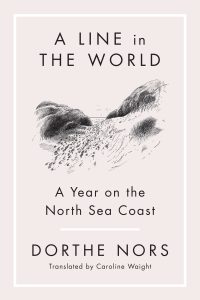Reviewed by Morgan Byerley

A Line in the World by Danish author Dorthe Nors takes the reader on an adventure traveling the west coast of Denmark. Through keen observation and lyrical lines, Nors paints a landscape that is both rugged and beautiful, contained and infinite. From hiking the jagged cliff of Bulbjerg to contemplating the role of frescoes in churches, A Line in the World draws connections between seemingly unconnected subjects. How does humanity understand their role within nature? What is the purpose of tradition that is passed down and the emerging culture that creates our identity? In a series of essays, Nors invites readers to walk alongside her as she travels the dynamic line of the Danish coast. She grapples with the purpose of the past, the challenges of the present, and the hopeful yet uncertain future that is still to be written.
Nors begins the book by considering the tensions between the East and West. The West is her childhood home and the untamed islands of the Danish coast. The East is Copenhagen, Sweden, and the life she tried to build away from her roots. This tension that exists within identity is one of the many topics Nors explores in her expansive essays. She begins most essays with a personal story, interwoven with minute details only a native to the Danish coast could notice. She describes the raging sea during a summer storm, her childhood cabin nestled on the vast coast of Limfjord, the way a sailboat bobs along the water. As both a narrator and a tour guide, Nors draws connections between her personal experiences and the larger challenges faced by humanity.
Through her journeys, Nors considers the role of humanity’s relationships within nature. Nature is described as a living force: the violent ocean holds memories from centuries long ago. The North Sea is the same sea that the Viking raiders once sailed across, discovering new lands and building an oceanic empire. It’s the same ocean, the same coastline, yet it’s also distinctly different. Today where Vikings once sailed, windmills now rise out of the water. Spinning white blades have replaced large timber ships. Nors questions the role nature plays in the lives of humans and people’s irreversible decisions that impact the natural world. The ocean has sunk thousands of ships. Through violent, inhuman storms, the wind and waters have eroded miles of coastlines, turning the highest cliffs into crumbling dust. Yet in this same water and along the same coastline, humans have pumped toxic and waste chemicals into the salty water. These toxins have changed entire ecosystems and have left humanity’s mark on the natural world. The relationship between humans and nature is one of complexity. The land is alive, it is speaking to us, and Nors asks us to stop and listen to its voice.
Nors most powerful skill is the ability to create a single image from words. She describes how art gives us a look into alternative dimensions. She marvels at the architecture that reminds us of lives lived hundreds of years ago. One essay describes how Nors and her friend Signe took a fresco trip along the Danish coast. Their goal was to visit all the major churches in order to study Danish frescoes. As her friend sketched frescoes in her notebook, Nors sat in a church pew drinking coffee and contemplating art’s significance. She spent hours staring into the depths of the frescoes and considering their implications for history. Art is more than a picture but a vehicle of human expression and the ability to capture moments of history. From special doors in churches to the expression of Mary, Nors contemplates the role art plays in shaping history and our present times.
After reading A Line in the World, readers will develop a desire to travel to the North Sea and experience the rich and rugged beauty of the Danish coast. With personal essays, Dorthe Nors draws the reader into her world as she reflects on her travels and Danish culture. Her essays, with powerful images and lyrical writing, create a world of beauty. From vivid descriptions of the ocean to heartfelt stories of community, Nors has written a memorable book that captures the soul of western Denmark.
A Line in the World: A Year on the North Sea Coast by Dorthe Nors, translated by Caroline Waight: Graywolf Press, 2022, 240 pages, Minneapolis, MN
